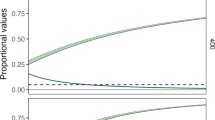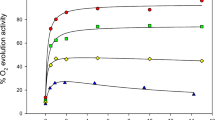Abstract
The influence of various concentrations of the thiol isomer of Systox on Rb absorption by excised barley leaf tissue was compared with the effect of DNP and DCMU.
Rb absorption, regardless of the external salt concentration, was progressively reduced as the Systox concentration in the external solution was increased from 0.25 to 1.0 mM. Under anaerobic conditions, light-enhanced Rb absorption by leaf tissue was not influenced by Systox treatments.
DNP treatment reduced ion absorption by leaf tissue. In the dark, the relative inhibitory effect of DNP and Systox treatment on Rb absorption was greater than in the light. The combination of Systox plus DNP inhibited Rb absorption more than did separate treatment with either compound.
DCMU treatments in the light resulted in a reduction of light-enhanced Rb uptake. Also in the light, the combination of DCMU with Systox, DNP, or both, inhibited Rb uptake more than did separate treatments of Systox, DNP, or Systox plus DNP.
It is suggested that the inhibitory effect of Systox on Rb absorption by leaf tissue is due to partial inhibition of oxidative phosphorylation. Moreover, since light-enhanced Rb absorption is not affected by Systox, it is concluded that Systox has no effect either on the photophosphorylation reactions or on the utilization of high-energy phosphorylated compounds.
Similar content being viewed by others
References
Arnon, D. I., H. Y. Tsujimoto, and B. H. McSwain: Ferrodoxin and photosynthetic phosphorylation. Nature214, 562 (1967).
Budd, K., and G. G. Laties: Ferricyanide-mediated transport of chloride by anaerobic corn roots. Plant Physiol.39, 648 (1964).
Fukuto, T. R., R. L. Metcalf, R. B. March, and M. G. Maxon: Chemical behavior of Systox in biological systems. J. Econ. Entomol.48, 347 (1955).
Jacobson, L., R. J. Hannapel, D. P. Moore, and M. Schaedle: Influence of calcium on selectivity of ion absorption process. Plant Physiol.36, 58 (1961).
Jeschke, W. D.: Die cyclische und die nicht-cyclische Photophosphorylierung als Energiequellen der lichtabhängigen Chloridionenaufnahme beiElodea. Planta.73, 161 (1967).
Kholdebarin, B., and J. J. Oertli: Effects of metabolic inhibitors on salt uptake and organic acid synthesis by leaf tissue in the light and in the dark. Zeitschrift für Pflanzenphysiologie66, 352 (1972).
MacRobbie, E. A. C.: The nature of the coupling between light energy and active ion transport inNitella translucens. Biochem. Biophys. Acta.94, 64 (1965).
MacRobbie, E. A. C.: Metabolic effects of ion fluxes inNitella translucens. I. Active influxes. Aust. J. Biol. Sci.19, 363 (1966).
Neuman, J., and A. T. Jagendorf: Dinitrophenol as an uncoupler of photosynthetic phosphorylation.-Biochem. Biophys. Res. Commun.16, 562 (1964).
Oertli, J. J., and N. Ahmadi: The effect of systox on ionic fluxes in excised barley roots. Arch. Env. Cont. and Toxicology3, 97 (1975).
Rains, D. W.: Light-enhanced potassium absorption by corn leaf tissue. Science156, 1382 (1967).
Rains, D. W.: Kinetics and energetics of light-enhanced potassium absorption by corn leaf tissue. Plant Physiol.43, 394 (1968).
Robertson, R. N., M. J. Wilkins, and D. C. Weeks: Studies in the metabolism of plant cells. IX. The effect of 2,4-dinitrophenol on salt accumulation and salt respiration. Aust. J. Sci. Res. (B)4, 248 (1951).
Smith, F. A.: Active phosphate uptake byNitella translucens. Biochem. Biophys. Acta.126, 94 (1966).
Smith, R. C., and E. Epstein: Ion absorption by shoot tissue: Kinetics of K and Rb absorption by corn leaf tissue. Plant Physiol.39, 992 (1964).
Springer-Lederer, H., and D. L. Rosenfeld: Absorption of rubidium byChlorella. Physiol. Planta.21, 435 (1968).
Sutcliff, J. F., and D. P. Hackett: Efficiency of ion transport in biological system, Nature180, 95 (1957).
Weigl, J.: Uber den Zusammenhang von Photophosphorylierung und aktiver Ionenaufnahme. Z. Naturforsch.19b, 845 (1964).
Weigl, J.: Evidence for mobile transport structures (carriers) involved in ion transport in plants and kinetics of anion transport inElodea in light and dark. (English translation). Planta.75, 327 (1967).
Author information
Authors and Affiliations
Rights and permissions
About this article
Cite this article
Ahmadi, N., Oertli, J.J. The effect of systox on rubidium absorption by excised barley leaf tissue. Arch. Environ. Contam. Toxicol. 3, 107–114 (1975). https://doi.org/10.1007/BF02220781
Received:
Accepted:
Issue Date:
DOI: https://doi.org/10.1007/BF02220781




